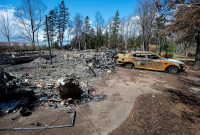Support strong Canadian climate journalism for 2025
More than seven weeks after a man disguised as a Mountie killed 22 people in rural Nova Scotia, the RCMP have finally hinted at what may have motivated one of the worst mass killings in Canadian history.
Last week, RCMP Supt. Darren Campbell told a briefing that a behavioural analysis of the killer determined he was an "injustice collector" — a term that is well known among criminologists.
But what does that description really mean? And what does it tell us about the 51-year-old denture-fitter responsible for so much carnage and mayhem?
"It's a way of seeing the world," says Tracy Vaillancourt, Canada Research Chair in Children's Mental Health and Violence Prevention at the University of Ottawa.
The term was coined by Mary Ellen O'Toole, a former FBI profiler who is now a director of the forensic science department at George Mason University in Virginia.
Michael Arntfield, a professor and criminologist at Western University in London, Ont., says injustice collectors are disproportionately middle-aged males who have tabulated an inventory of every perceived slight over the course of their lives.
"Injustice collectors have a negative or adversarial interpretation of every encounter," he says. "It's their default setting.
They can nurture grudges for years. They often feel cheated or disrespected by others, even though there may be no evidence to support those beliefs. And these negative thoughts often get stuck on an endless, self-fulfilling loop.
Vaillancourt prefers the term "anger rumination."
"It creates a threat-sensitive brain that is always looking for evidence to confirm the world is against them," says Vaillancourt, a professor who specializes in the study of violence.
"It builds up to be an internal narrative of: 'These people are jerks. These people are bad. They deserve what they get.' They become desensitized to the suffering of their victims."
Witness statements, documents and police disclosures confirm the killer, Gabriel Wortman, displayed many of these traits — though not all the time.
According to court records, his relationship with an uncle soured in July 2015 after Wortman lost a legal battle involving a shared property in Portapique, N.S., the tiny community where he started his homicidal rampage on the night of April 18.
Longtime neighbour John Hudson says the killer made a point of burning his uncle's former home that night, even though he had moved away years ago. Among Wortman's first victims was 49-year-old teacher Lisa McCully, who had purchased the uncle's former home.
"It didn't have anything to do with Lisa," Hudson speculated in an interview in April. "He didn't have her in mind. He was thinking of the problems he had with his uncle."
Hudson also recalled how Wortman was particularly perturbed about stonework on a neighbour's log home, which resembled the style of his own home.
"He would tell me, 'They've just disgraced that place.' He thought they were copying him. He did worry about those things."
Arntfield, a workplace violence consultant and former police detective, says the focus on petty grievances is consistent with injustice collecting.
"Over the course of their lifetime, this reaches critical mass, and some act out," he says.
Wortman killed 13 people in Portapique before slaying another nine people the following day in several communities in northern and central Nova Scotia. He was fatally shot by a Mountie at a gas station in Enfield, N.S.
The RCMP said the killer's victims fall into one of three categories.
"Some recipients of his wrath of violence were targeted for perceived injustices of the past, others were reactive targets of his rage and others were random targets," Campbell told an RCMP briefing last Thursday.
Vaillancourt says anger rumination can sometimes be linked to growing up in a hostile environment, though that is not always the case.
In a police document used to obtain a search warrant, one witness described Wortman as a smart psychopath who had been abused as a boy and was paranoid about the COVID-19 pandemic.
However, even though Wortman routinely had run-ins with neighbours, police and others in authority, those types of interactions are not reliable predictors for violent behaviour, Vaillancourt says.
"There's a lot of people who are injustice collectors," she says. "Your next-door neighbour might be one. You're mom might be one. There's a lot of people who view the world this way and don't go on a shooting rampage."
Still, Wortman's history of domestic violence was well known among some of his neighbours, and police have confirmed the killings started shortly after he assaulted his long-term common law wife, who survived the attack.
Intimate partner violence is a strong indicator that an individual is more likely to be violent towards others.
Arntfield, who works with the Canadian Association of Threat Assessment Professionals, says experts can use actuarial tools to spot potentially violent injustice collectors among terminated employees.
These tools, which include the MOSAIC threat-assessment system in the U.S., are also used by politicians and other public officials to determine the threat posed by people sending threatening correspondence.
One key trait is the use of pseudo-legal language. Other clues include obsessions with police or the military and access to firearms, both of which applied to Wortman.
This report by The Canadian Press was first published June 8, 2020.





Comments
The cars he stopped had lone women in them. It was a lone woman walking her dog. It was a lone woman in Shubrnacadie who was murdered. Psychological evaluation tools are only as good as societal standards. In a society that is unwilling to acknowlede misogyny and femicide neither will be attributed in a profile. Until femicide is acknowledged and fully considered randomness may be attributed inappropriately.
I agree completely. This sounds like a patriarchial system, grasping at very tenuous straws. Obscure terminology they reach for in desperation to avoid calling out misogyny for what it is. We've also heard recently excuses made for Marc Lépine, as in 'we may never know why he killed those students,' when in fact we know exactly why. Marc Lépine’s page-long suicide note made his motivations clear: “Feminists have always enraged me,” he wrote. “I have decided to send the feminists, who have always ruined my life, to their Maker.”